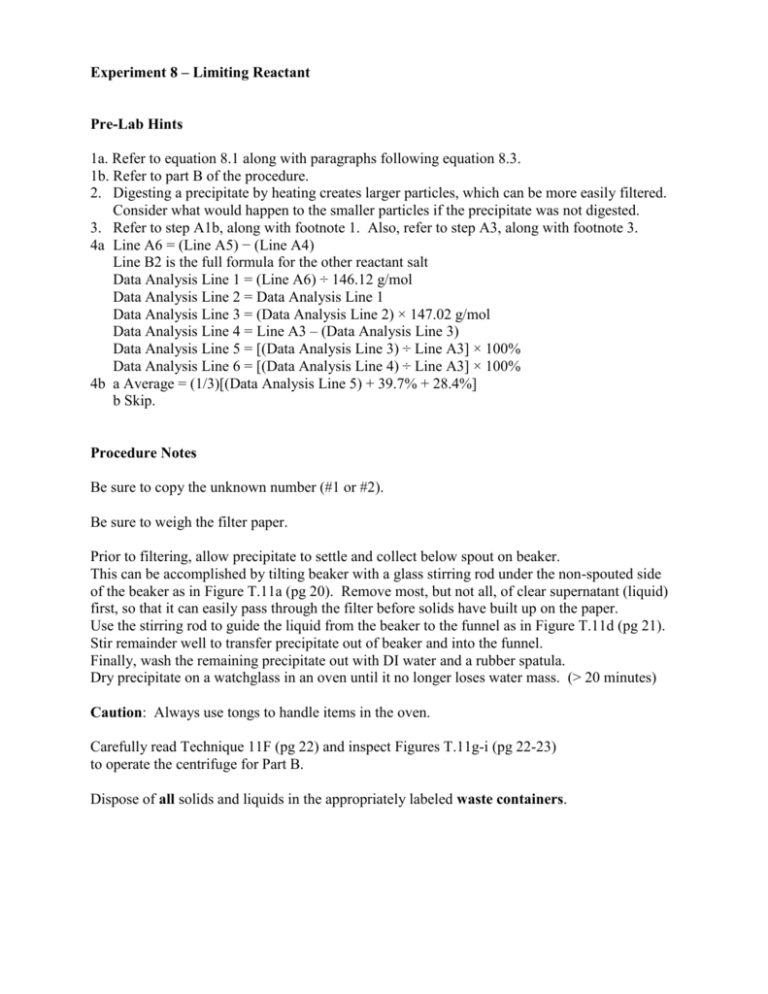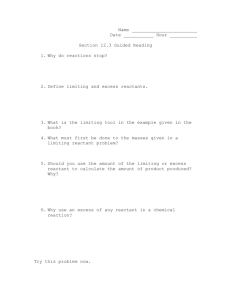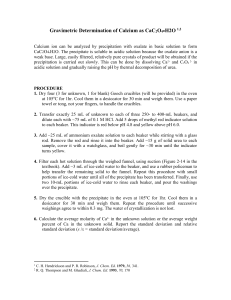Limiting Reactant Lab Experiment: Procedure & Calculations
advertisement

Experiment 8 – Limiting Reactant Pre-Lab Hints 1a. Refer to equation 8.1 along with paragraphs following equation 8.3. 1b. Refer to part B of the procedure. 2. Digesting a precipitate by heating creates larger particles, which can be more easily filtered. Consider what would happen to the smaller particles if the precipitate was not digested. 3. Refer to step A1b, along with footnote 1. Also, refer to step A3, along with footnote 3. 4a Line A6 = (Line A5) − (Line A4) Line B2 is the full formula for the other reactant salt Data Analysis Line 1 = (Line A6) ÷ 146.12 g/mol Data Analysis Line 2 = Data Analysis Line 1 Data Analysis Line 3 = (Data Analysis Line 2) × 147.02 g/mol Data Analysis Line 4 = Line A3 – (Data Analysis Line 3) Data Analysis Line 5 = [(Data Analysis Line 3) ÷ Line A3] × 100% Data Analysis Line 6 = [(Data Analysis Line 4) ÷ Line A3] × 100% 4b a Average = (1/3)[(Data Analysis Line 5) + 39.7% + 28.4%] b Skip. Procedure Notes Be sure to copy the unknown number (#1 or #2). Be sure to weigh the filter paper. Prior to filtering, allow precipitate to settle and collect below spout on beaker. This can be accomplished by tilting beaker with a glass stirring rod under the non-spouted side of the beaker as in Figure T.11a (pg 20). Remove most, but not all, of clear supernatant (liquid) first, so that it can easily pass through the filter before solids have built up on the paper. Use the stirring rod to guide the liquid from the beaker to the funnel as in Figure T.11d (pg 21). Stir remainder well to transfer precipitate out of beaker and into the funnel. Finally, wash the remaining precipitate out with DI water and a rubber spatula. Dry precipitate on a watchglass in an oven until it no longer loses water mass. (> 20 minutes) Caution: Always use tongs to handle items in the oven. Carefully read Technique 11F (pg 22) and inspect Figures T.11g-i (pg 22-23) to operate the centrifuge for Part B. Dispose of all solids and liquids in the appropriately labeled waste containers. Calculations Show all calculations for trial 1 on a separate sheet of paper. Subtract beaker mass from combined beaker and salt mass to get salt mass. A3 = A2 – A1 Subtract filter paper mass from combined paper and product mass to get product mass. A7 = A5 – A4 (Skip A6) Divide dry CaC2O4 precipitate mass by formula weight to determine its moles. Data Analysis Line 1 = A7 / (128.10 g/mole) There is 1 mole of CaC2O4 to 1 mole of limiting reactant. Line 2 = Line 1 Multiply moles by molar mass (184.24 for K2C2O4·H2O or 147.02 for CaCl2·2H2O) to find mass of limiting reactant. Line 3 = Line 2 × (Mm) Subtract mass of limiting reactant from original sample mass (salt mixture) to find total mass of other (excess) reactant. Line 4 = A3 – Line 3 Divide calculated masses by original sample mass to obtain mass %’s. Line 5 = (Line 3 / A3) × 100% and Line 6 = (Line 4 / A3) × 100% There is 1 mole of CaC2O4 to 1 mole of excess reactant that reacted. Multiply the moles reacted by the reactant’s formula weight to find the mass that reacted. Line 7 = Line 2 × (Mm) To find the mass excess reactant that did not react, subtract the mass of the excess reactant that did react from the total mass of excess reactant. Line 8 = Line 4 – Line 7 Lab Questions 1. Suppose one lab group did not heat their solution in order to digest the precipitate. Consider the hint for pre-lab question 2. How would this affect the mass of solid product collected? Explain how this affects the moles calculated for the limiting reactant. 2. Suppose you touched your filter paper with wet fingers immediately before weighing it. What happens to its initial mass measurement? After you collected your precipitate on the filter paper, you dried the solid and filter paper thoroughly before obtaining the final weight. What happens to the final mass measurement? Explain how the calculation for the solid precipitate mass is affected. 3. Suppose some of the solid is not washed out of the beaker and into the filter. How will the mass of solid collected be affected? Explain how this affects the mass percentage for the limiting reactant. 4. Suppose the oven did not maintain > 110oC because it was continually opened and closed. See step A7. What will be the chemical identity of the product? How would this affect the mass of product collected? 5. Suppose you obtained the hydrate as your product, but you assumed that it was anhydrous. How will the mass of solid collected be affected? Explain how your assumption affects the moles of product calculated.








